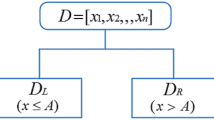Abstract
Cervical cancer is one of the predominant cancers that cause death in women globally. This disease progresses slowly and is a curable cancer, if detected well in advance. Various studies on different data mining models used for diagnosing this disease have been carried out. Different approaches including support vector machine and recursive feature elimination (SVM-RFE) and support vector machine and principal component analysis (SVM-PCA) had been designed for cervical cancer diagnosis. However, these pose various challenges including low accuracy and high processing time for classification. The proposed system addresses these issues by designing a long short-term memory with artificial bee colony (LSTM-ABC) algorithm for cervical cancer detection. The study takes the cervical cancer dataset as an input and uses synthetic minority oversampling technique (SMOTE) for solving the class imbalance issue. From the preprocessed data, the feature selection is performed using artificial bee colony (ABC) algorithm. Long short-term memory (LSTM) scheme is then employed for classifying cervical cancer based on the selected features. Experimental outcomes demonstrate that the proposed system delivers superior results than the previous works with respect to sensitivity, accuracy, and specificity.
Access this chapter
Tax calculation will be finalised at checkout
Purchases are for personal use only
Similar content being viewed by others
References
J.C. Susan, H.K. Alex, Screening for cervical cancer US preventive services task force recommendation statement. JAMA 320, 674–686 (2018)
C.S.C. Robbins, C. Pang, J. Leask, Australian newspaper coverage of human papillomavirus vaccination, October 2006–December 2009. J Health Commun. 17, 149–159 (2011)
R.A. Kerkar, Y.V. Kulkarni, Screening for cervical cancer: an overview. J. Obstet. Gynecol. India 56(2), 115–122 (2006)
G. Guvenc, A. Akyuz, C.H. Açikel, Health belief model scale for cervical cancer and Pap smear test: psychometric testing. J. Adv. Nurs. 67(2), 428–437 (2011)
M.T. Galgano, P.E. Castle, K.A. Atkins, W.K. Brix, S.R. Nassau, M.H. Stoler, Using biomarkers as objective standards in the diagnosis of cervical biopsies. Am. J. Surg. Pathol. 34(8), 1077 (2010)
H. Ramaraju, Y. Nagaveni, A. Khazi, Use of Schiller’s test versus Pap smear to increase detection rate of cervical dysplasias. Int. J. Reprod. Contracept. Obstet. Gynecol. 5, 1446–1450 (2017)
T.M. Alam, M.M.A. Khan, M.A. Iqbal, W. Abdul, M. Mushtaq, Cervical cancer prediction through different screening methods using data mining. IJACSA Int. J. Adv. Comput. Sci. Appl. 10(2), (2019)
Z. Rustam, V.A.W. Hapsari, M.R. Solihin, Optimal cervical cancer classification using Gauss-Newton representation based algorithm. in AIP Conference Proceedings, Vol. 2168, No. 1, (AIP Publishing LLC, 2019 Nov), p. 020045
F.Q. Li, S.L. Wang, G.S. Liu, A Bayesian possibilistic C-means clustering approach for cervical cancer screening. Inf. Sci. 501, 495–510 (2019)
W. Yang, X. Gou, T. Xu, X. Yi, M. Jiang, Cervical cancer risk prediction model and analysis of risk factors based on machine learning. in Proceedings of the 2019 11th International Conference on Bioinformatics and Biomedical Technology (2019), pp. 50–54
B. Benazir, A. Nagarajan, An expert system for predicting the cervical cancer using data mining techniques. Int. J. Pure Appl. Math. 118(20), 1971–1987 (2018)
C.J. Tseng, C.J. Lu, C.C. Chang, G.D. Chen, Application of machine learning to predict the recurrence-proneness for cervical cancer. Neural Comput. Appl. 24(6), 1311–1316 (2014)
W. Wu, H. Zhou, Data-driven diagnosis of cervical cancer with support vector machine-based approaches. IEEE Access 5, 25189–25195 (2017)
K. Fernandes, J.S. Cardoso, J. Fernandes, Transfer learning with partial observability applied to cervical cancer screening, in Proceedings of 2017 Iberian Conference on Pattern Recognition and Image Analysis. Lecture Notes in Computer Science, vol. 10255, (2017), pp. 243–520
S. Barua, M.M. Islam, K. Murase, A novel synthetic minority oversampling technique for imbalanced data set learning. in International Conference on Neural Information Processing (Springer, Berlin, Heidelberg, 2011 Nov), pp. 735–744
M.S. Kıran, O. Fındık, A directed artificial bee colony algorithm. Appl. Soft Comput. 26, 454–462 (2015)
G. Yu, A new multi-population-based artificial bee colony for numerical optimisation. Int. J. Comput. Sci. Math. 7(6), 509–515 (2016)
S.S. Jadon, R. Tiwari, H. Sharma, J.C. Bansal, Hybrid artificial bee colony algorithm with differential evolution. Appl. Soft Comput. 58, 11–24 (2017)
Author information
Authors and Affiliations
Corresponding author
Editor information
Editors and Affiliations
Rights and permissions
Copyright information
© 2021 The Author(s), under exclusive license to Springer Nature Singapore Pte Ltd.
About this paper
Cite this paper
Priya, S., Karthikeyan, N.K. (2021). Deep Learning Classification to Improve Diagnosis of Cervical Cancer Through Swarm Intelligence-Based Feature Selection Approach. In: Paprzycki, M., Thampi, S.M., Mitra, S., Trajkovic, L., El-Alfy, ES.M. (eds) Intelligent Systems, Technologies and Applications. Advances in Intelligent Systems and Computing, vol 1353. Springer, Singapore. https://doi.org/10.1007/978-981-16-0730-1_17
Download citation
DOI: https://doi.org/10.1007/978-981-16-0730-1_17
Published:
Publisher Name: Springer, Singapore
Print ISBN: 978-981-16-0729-5
Online ISBN: 978-981-16-0730-1
eBook Packages: Intelligent Technologies and RoboticsIntelligent Technologies and Robotics (R0)




